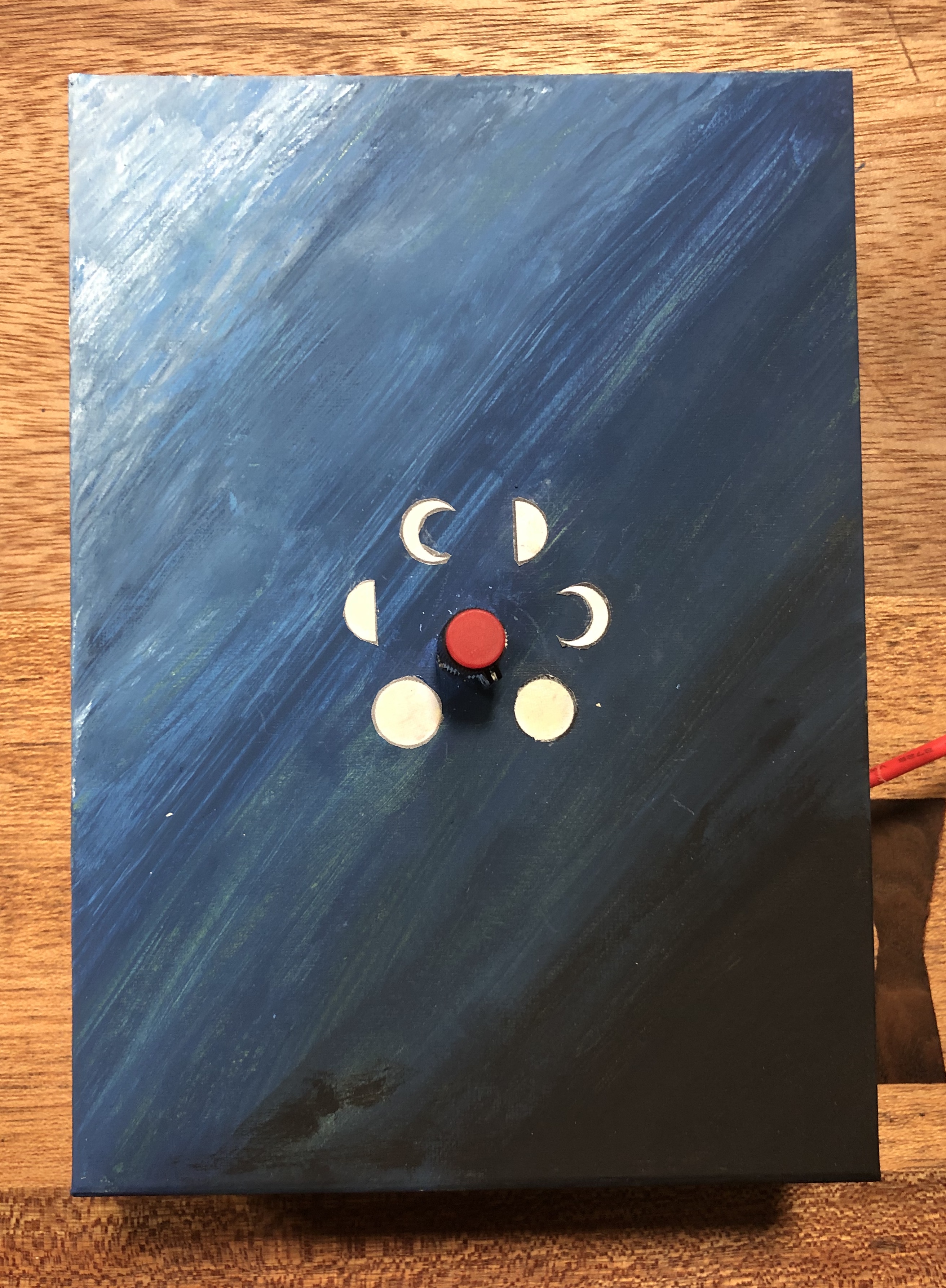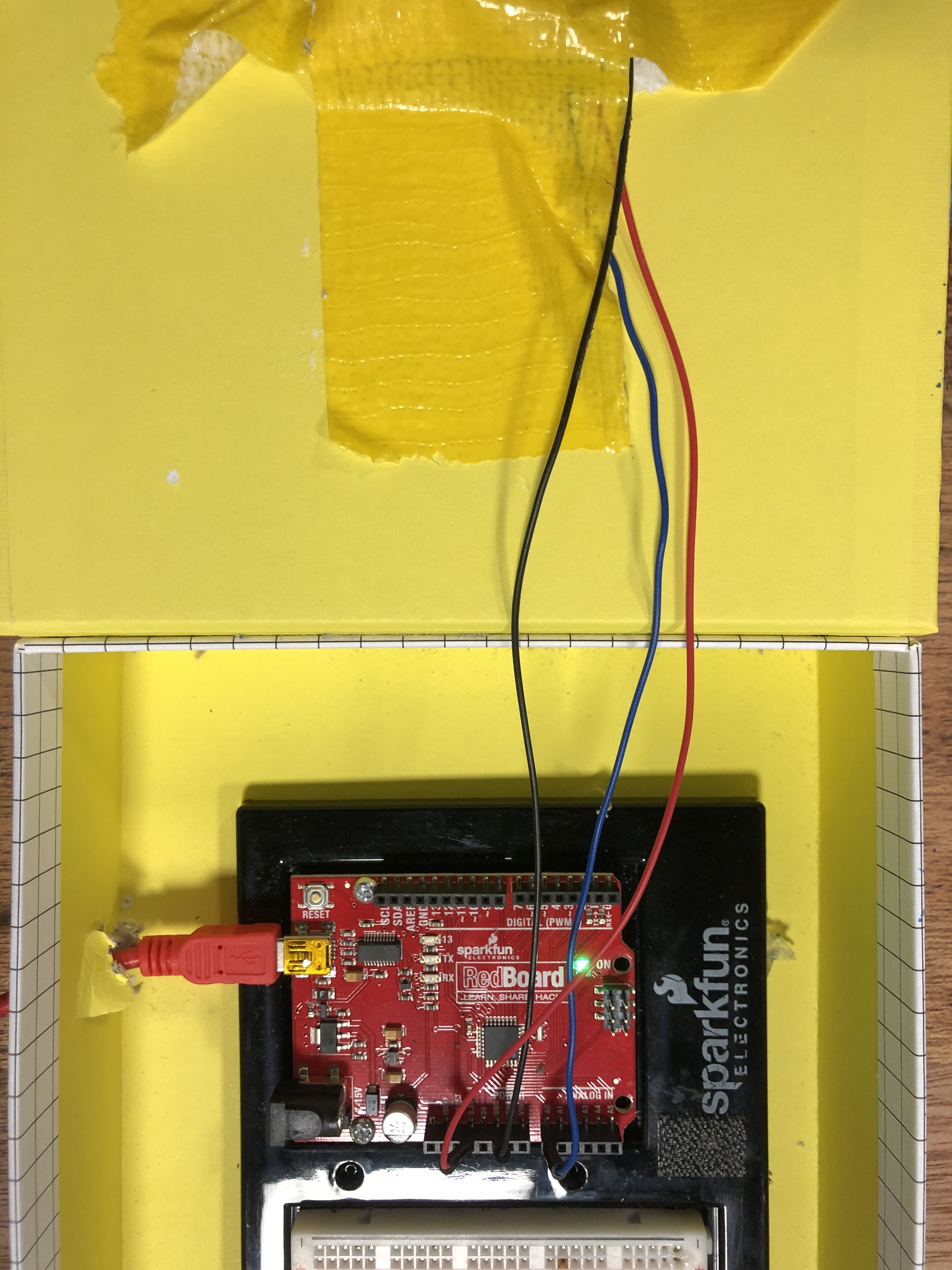For this week’s assignment, we were asked to create a project that combines both Arduino and Processing by allowing them to perform a serial “handshake”.
To do this, I used my OOP processing project and replaced the mouse interaction with a rotary potentiometer. This was, for the most part, easy to do. We completed an in-class example where we controlled a basic ellipse shape across the X-axis as well, and I was surprised that I could apply the same simple code (with a few minor tweaks) to a processing sketch that was a bit more complex, without breaking the code.
Here is a video demonstration:
I created a box for the potentiometer, in an attempt to make it a little bit more visually appealing.
Here’s my code:
Arduino:
void setup() {
// put your setup code here, to run once:
Serial.begin(9600);
Serial.println('0');
}
void loop() {
if(Serial.available()>0){
char inByte=Serial.read();
int sensor = analogRead(A0);
delay(0);
Serial.println(sensor);
}
}
Processing:
//arrayList to hold all stars
ArrayList<Star> stars = new ArrayList<Star>();
import processing.serial.*;
Serial myPort;
int xPos=0;
int State = 0;
//instantiate new moon object
Moon moon = new Moon();
int modifier;
float raindrop;
int red, green, blue;
void setup()
{
size(585,430);
background(0);
raindrop= 0;
printArray(Serial.list());
String portname=Serial.list()[1];
println(portname);
myPort = new Serial(this,portname,9600);
myPort.clear();
//myPort.bufferUntil('\n');
//generate 30 random stars
for (int i = 0; i < 30; i++)
{
//adds them to star ArrayList for easy access
stars.add(new Star());
}
}
void draw()
{
//move raindrop down screen
raindrop = raindrop + 4; //speed
//if raindrop falls below canvas, reset to zero
if (raindrop >= height)
raindrop = 0;
//map xPos to rgb values of background
red = int(map(xPos, 0, width, 83, 0));
green = int(map(xPos, 0, width, 157, 0));
blue = int(map(xPos, 0, width, 253, 0));
modifier = int(map(xPos, width/2, width, 29, 0));
background(red, green, blue);
if (xPos > width/2)
{
for (int i = 0; i < stars.size() - modifier; i++)
{
Star s = stars.get(i);
s.drawStar();
}
}
moon.update();
moon.drawMoon();
//rainfall
fill(211,211,211);
rect(10, raindrop, 2, 5);
rect(50, raindrop+20, 2, 5);
rect(80, raindrop, 2, 5);
rect(110, raindrop+100, 2, 5);
rect(140, raindrop+150,2, 5);
rect(180, raindrop-200, 2, 5);
rect(200, raindrop-150, 2, 5);
rect(240, raindrop-50, 2, 5);
rect(240, raindrop, 2, 5);
rect(300, raindrop+20, 2, 5);
rect(440, raindrop, 2, 5);
rect(440, raindrop, 2, 5);
rect(550, raindrop+100, 2, 5);
rect(530, raindrop-250, 2, 5);
rect(530, raindrop-200, 2, 5);
rect(580, raindrop-300, 2, 5);
rect(300, raindrop-400, 2, 5);
rect(140, raindrop-350, 2, 5);
rect(400, raindrop-300, 2, 5);
rect(400, raindrop-250, 2, 5);
rect(400, raindrop-200, 2, 5);
rect(550, raindrop, 2, 5);
//this part of my code uses & adapts from "skyline" by Shiwen Qin on OpenProcessing
//building 1
fill(250);
rect(35,255,5,55);
fill(250);
rect(40,250,40,60);
fill(51, 51, 51);
quad(80,250,80,310,95,310,95,260);
fill(106,106,71);
for (int y=258; y<310; y+=8){
fill(106,106,71);
rect(36,y,2,2);
}
for (int y=258; y<300;y+=10){
for(int x=44; x<78; x+=10){
fill(106,106,71);
rect(x,y,3,3);
}
}
//building 2
fill(51, 51, 51);
rect(93,265,40,60);
for (int y=270; y<300;y+=10){
for(int x=96; x<130; x+=10){
fill(165,160,102);
rect(x,y,5,3);
}
}
//building 3
fill(220,220,220);
rect(150,225,15,120);
fill(220,220,220);
rect(164,215,10,140,6);
fill(169,169,169);
rect(166,218,2,140,7);
fill(105,105,105);
arc(170,250,70,70,-PI/2,0);
rect(170,250,35,140);
fill(192,192,192);
arc(170,250,60,60,-PI/2,0);
rect(170,250,30,140);
fill(192,192,192);
arc(170,250,40,40,-PI/2,0);
rect(170,250,20,140);
//fourth building
fill(250);
fill(250);
rect(235,225,5,75);
fill(250);
rect(240,225,40,80);
fill(106,106,71);
for (int y=258; y<310; y+=8){
fill(106,106,71);
rect(236,y,2,2);
}
for (int y=258; y<300;y+=10){
for(int x=244; x<278; x+=10){
fill(106,106,71);
rect(x,y,3,3);
}
}
// fifth building
fill(102, 102, 102);
rect(300,185,36,120);
fill (51, 51, 51);
rect (295, 185, 5, 120);
rect (305, 185, 5, 120);
//sixth building
fill(51, 51, 51);
rect(376,172,2,10);
rect(375,180,3,15);
quad(350,206,350,316,380,316,380,190);
fill(102, 102, 102);
quad(375,198,375,316,405,316,405,215);
fill(51, 51, 51);
rect(387,215,1,115);
rect(396,215,1,115);
//seventh building
fill(51, 51, 51);
rect(430,200, 40 ,150);
fill(250);
rect(430,200, 40 ,5);
rect(470,200, 2 ,150);
//seventh building .2
fill(192,192,192);
rect(490,200, 40 ,150);
fill(250);
rect(490,200, 40 ,5);
rect(500,200, 2 ,150);
//eighth building
fill(51, 51, 51);
rect(225,225,10,120);
rect(270,225,10,120);
//building 8
arc(540,190,70,70,-PI*4/6,-PI*1/6,CHORD);
quad(523,159,523,325,570,325,570,172);
for(int y=170;y<325 ;y+=5){
fill(106,106,71);
quad(523,y,570,y+2,570,y+4,523,y+2);
}
//ninth building
fill(51, 51, 51);
quad(585,165,615,155,620,325,585,325);
fill(31,30,72);
triangle(614,155,622,158,619,325);
for(int y=210;y<325 ;y+=5){
fill(106,106,71);
quad(585,y,615,y-1,615,y+1,585,y+2);
}
for(int y=210;y<325 ;y+=5){
fill(64,64,34);
quad(615,y-1,621,y,621,y+2,615,y+1);
}
//shore
fill(69, 137, 163);
rect(0,310,900,400);
//mangroves, forloop
for(int x=0;x<900;x+=20){
mangroves(x,310,10,10,3,28,5,255);
//varying parameters for mangroves
mangroves(x+10,305,8,8,6,41,8,255);
mangroves(x+5,300,5,4,14,62,17,255);
}
}
void cloud(int x,int y,int w,int h,int red,int green,int blue,int a){
fill(red,green,blue,a);
ellipse(x,y,w,h);
}
//sets variables they're being created in
void mangroves(int x,int y,int w,int h,int red,int green,int blue,int a){
fill(red,green,blue,a);
ellipse(x,y,w,h);
ellipse(x+5,y+5,w,h);
ellipse(x-5,y-3,w,h);
ellipse(x+3,y-5,w,h);
ellipse(x-3,y+5,w,h);
}
void serialEvent(Serial myPort){
String s=myPort.readStringUntil('\n');
s=trim(s);
if (s!=null)
xPos=(int)map(int(s),0,650,0, width); //jere
println(xPos);
myPort.write(State);
}
class Moon
{
int x;
int y;
int sizeMod = 0;
Moon()
{
//instantiate moon at x = 60, y = 90
this.x = 60;
this.y = 90;
}
void drawMoon()
{
int blue, green;
//map xPos to green and blue rgb values for moon
green = int(map(xPos, 0, width, 221, 250));
blue = int(map(xPos, 0, width, 0, 205));
noStroke();
fill(255, green, blue);
//map Pos X to rgb values for background/sky
int bg_red = int(map(xPos, 0, width, 83, 0));
int bg_green = int(map(xPos, 0, width, 157, 0));
int bg_blue = int(map(xPos, 0, width, 253, 0));
//map xPos to variable sizeMod, starting at 0, ending at 20
sizeMod = int(map(xPos, 0, width/6, 0, 20));
//width/6 divides canvas into 6, for each moon/sun phase
if (xPos <= width/6)
{
//sizeMod decreases size of moon, starts at 80, ends at 80 - 20 = 60
ellipse(x, y, 80 - sizeMod, 80 - sizeMod);
}
else if (xPos > width/6 && xPos <= 2 * (width/6))
{
arc(x, y, 60, 60, HALF_PI, 3 * HALF_PI, OPEN);
}
else if (xPos > 2 * width/6 && xPos <= 3 * width/6)
{
ellipse(x, y, 60, 60);
//draw two overlapping circles to give illusion of crescent moon
fill(bg_red, bg_green, bg_blue);
ellipse(x + 10, y, 50, 50);
}
else if (xPos > 3 * width/6 && xPos <= 4 * width/6)
{
ellipse(x, y, 60, 60);
//can't figure out how to flip arc, just cover with rectangle
fill(bg_red, bg_green, bg_blue);
rect(x - 30, y - 30, 30, 60);
}
else if (xPos > 4 * width/6 && xPos <= 5 * width/6)
{
ellipse(x, y, 60, 60);
//draw two overlapping circles to give illusion of crescent moon
fill(bg_red, bg_green, bg_blue);
ellipse(x - 10, y, 50, 50);
}
else
{
ellipse(x, y, 60, 60);
}
}
void update()
{
x = xPos;
}
}
class Star
{
int x;
int y;
Star()
{
//instantiate star with random x and random y values, every time you restart sketch it' random
this.x = int(random(0, width));
this.y = int(random(0, height/3));
}
void drawStar()
{
fill(255);
ellipse(x, y, -1.5, -1.5);
}
}



Great job on this Sara. The controller box is a really nice touch.